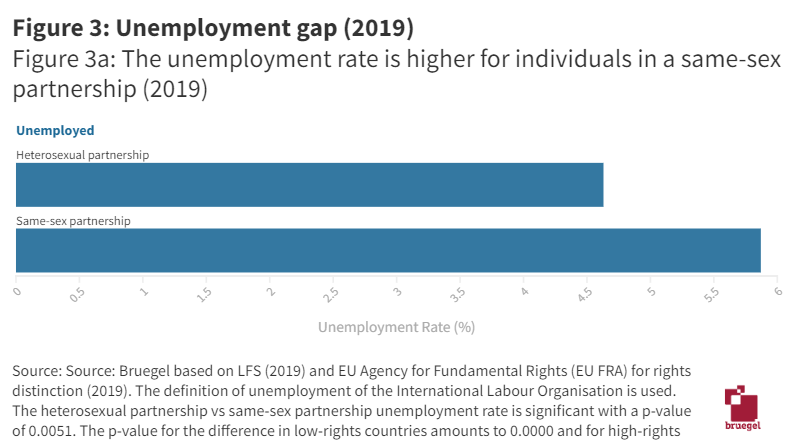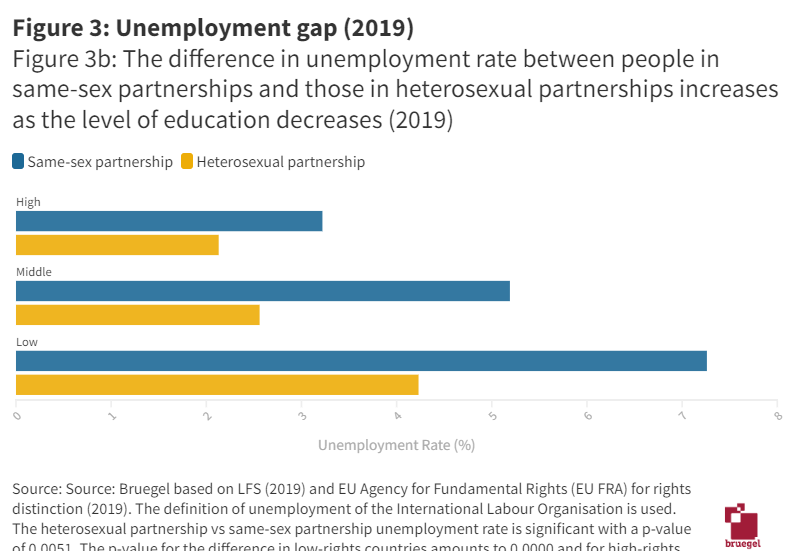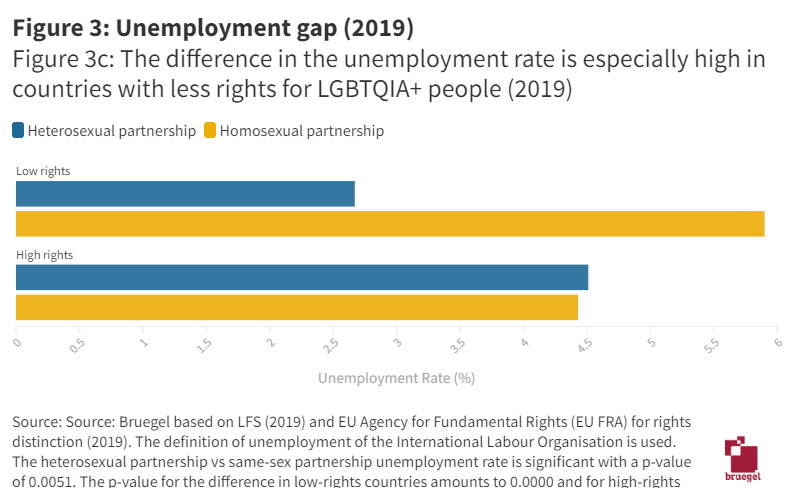While the rights of lesbian, gay, bisexual, transsexual, queer, intersex and asexual (LGBTQIA+) people are increasingly recognised in some European Union (EU) countries, in others official anti-LGBTQIA+ sentiment is on the rise, with the introduction of discriminatory measures. This raises the question of the extent to which LGBTQIA+ people experience discrimination in the EU labour market. Unfortunately, relevant data – especially in relation to bisexual, transsexual, queer, intersex and asexual people – is not easy to come by.
One reason for the lack of data is that not everyone wants to disclose their sexual orientation or gender identity because of a history of discrimination (referred to as non-disclosure bias). Thus, the data suffers from a selection bias against finding an LGBTQIA+ penalty in the labour market. Openness about being LGBTI (note: we use variations of the initials in this blog post depending on the groups under consideration) depends on other socio-economic and demographic characteristics: openness increases with age, education level, when in a partnership, when in paid work, and with more LGBTQIA+ rights in a country. This ‘social desirability bias’ means that survey respondents tend to answer questions in a way that will be viewed favourably by others. Thus the proportion of documented same-sex households is greater in more egalitarian countries (Figure 1).
Is there evidence of discrimination?
Nevertheless, evidence of discrimination can be assessed by constructing a group of people in same-sex partnerships and comparing them to people in a heterosexual partnership using the EU Labour Force Survey. Male-male and female-female partnerships are grouped together to reduce specific biases in LGBTQIA+ data (see annex for a list of these biases).
At first glance, people in same-sex partnerships seem to have more managerial responsibilities, with higher levels of education, and are in more skilled occupations. However, a closer look shows signs of discrimination.
Around 22.5% of people in a heterosexual partnership manage or supervise other employees at work compared with around 26% of those in a same-sex partnership. A study in the UK confirms that employed lesbians and gay men are more like to have managerial or supervisory roles, but warns that gay men face glass ceilings: they are significantly more likely to be low-level managers and are less likely to be in the highest-level managerial positions, relative to comparable heterosexual men. The high-level managerial occupation gap amounts to -6% for lesbian and bisexual women, and -16% for gay and bisexual men according to the OECD.
Another factor in the labour market is that people in a same-sex partnership are on average more highly educated (about 44%) compared to their heterosexual counterparts (28%), mostly driven by a big gap among the low educated rather than the middle educated (Figure 2).
This gap might be due to higher educated people being more likely to disclose their sexual orientation (see above). However, other research also provides evidence of an education gap.
It is more likely that people in same-sex partnerships attain higher levels of education in order to mitigate any potential effect on earnings due to discrimination and to have access to more tolerant workplaces. Levels of self-reported discrimination in the past 12 months at work or when looking for work confirm that the discrimination experienced decreases as the level of education increases (29% of those with lower secondary or less education reporting discrimination versus 21% for those with tertiary education). Additionally, Figure 3b shows that lower-educated people in same-sex partnerships experience more discrimination in terms of employment status. They are also more likely to choose occupations with task independence and social perceptiveness to protect them from harassment and discrimination.
The educational outcomes of sexual minorities can also depend on the timing of same-sex experiences and attraction. Evidence in the US suggests that educational attainment is lower for younger LGBT people compared to heterosexuals, as they have an increased likelihood of exposure to risk factors such as loss of parental support due to coming out earlier than older LGBT people.
Working status and reasons for leaving the last job
People in same-sex partnerships in the EU seem more likely to be unemployed than individuals in heterosexual partnerships, around 5.9% versus 4.6% (Figure 3a). However, before concluding that this is down to labour-market discrimination, other reasons such as such as differences in occupations or parental status must be discounted. Surveys will need to include the respondent’s self-reported sexuality and gender identity to increase available data and more accurately measure LGBTQIA+ discrimination.
Nonetheless, it seems that this difference in unemployment rate reflects discrimination. First, the non-disclosure bias results in an underestimation. Figure 3b shows that the difference in unemployment rate between people in a same-sex partnership and in a heterosexual partnership increases as education level decreases. So, if lower educated people are less likely to disclose their sexuality, the unemployment rate is underestimated. Additionally, unemployed people in a same-sex partnership are less likely to disclose their sexuality. Second, evidence from the United States indicates that LGBT individuals were more exposed to labour-market disruption in the pandemic, with 56% (compared to 44% of heterosexual individuals) reporting that they or someone in their household experienced COVID-era job loss; LGBT individuals were also more likely to see their work hours cut. Third, gay men and lesbian women are 1.8 times less likely to be called back by a recruiter than their heterosexual counterparts (based on 13 correspondence studies).
People in a same-sex partnership are also much more likely than individuals in a heterosexual partnership to have left their last job because they were dismissed or made redundant (20% versus 13%), because a job of limited duration has ended (26% versus 15%), or for “other reasons” (16% versus 10%). Finally, Figure 3c shows that the difference in unemployment rate is especially significant in countries with fewer equality and non-discrimination laws (5.9% versus 2.7%; rated by ILGA-Europe), indicating that laws can exert a powerful influence in shaping societal attitudes towards LGBTQIA+ people.
Unobserved effects that might help explain the difference in the unemployment rate, and that could be subject to more research when more data becomes available, include the impact of having children on EU labour market outcomes for people in same-sex partnerships compared to their heterosexual counterparts. People in same-sex partnerships are less likely to have children, particularly because of the increased cost. Studies have found that in heterosexual partnerships with children, men receive a wage premium and women a penalty. Thus, it is important to disentangle the impact of parental status from discrimination for those in same-sex partnerships.



Thus, though there is a clear need for better EU data on LGBTQIA+ people, there is already evidence that significant labour-market discrimination is taking place. Better data would enable biases to be addressed and policies to be designed to counteract the discrimination. The EU and its member states also need to continue to uphold the rights of LGBTQIA+ people, in order to reduce negative attitudes and, consequently, labour market discrimination.
Annex: A lack of resources to detect LGBTQIA+ labour-market discrimination
The European Commission mapped the existing sources of equality data relating to LGBTIA+ people. Although some sources exist, they are usually flawed for one or a combination of the following reasons: conducted sporadically (limiting comparability across time), targeting only LGBTQIA+ people (limiting representativeness and comparability with heterosexuals of labour-market outcomes), focused on the experience of discrimination and hate crime (limiting the ability to analyse labour-market discrimination) and organised on national level (limiting comparability across countries).
The European Union Labour Force Survey (LFS), meanwhile, provides relevant information to detect discrimination, including (un)employment, hours worked and type of work contracts. However, the sexuality or gender identity of respondents is not available. Nevertheless, it is possible to compare the labour situation of individuals in a same-sex household with those in a heterosexual household.
Understanding biases in LGBTQIA+ data
Specific biases present in LGBTQIA+ data include:
- Not everyone wants to disclose their sexual orientation or gender identity due to a history of discrimination (non-disclosure bias). Consequently, the data suffers from a selection bias running against finding an LGBTQIA+ penalty, as the openness about being LGBTI is dependent on other socio-economic and demographic characteristics: it increases with age, with education level, when in a partnership, when in paid work, and with the general LGBTQIA+ rights in the country (social-desirability bias).
- Because of a lack of a settled view on the exact size or demographic composition of the LGBTQIA+ population, it is difficult to estimate the representativeness of a sample.
- Sexual minorities almost always constitute less than 10% of the sample (depending on the population) and are often under-reported, making it difficult to achieve statistical significance (sample size and statistical power).
- In general, within a couple, household specialisation takes place: one focuses more on market-oriented activities, while the other focuses more on household activities. In patriarchal societies, women, on average, perform more household activities. It has only been partly counteracted by a general shift toward more egalitarian gender norms. Consequently, the labour market penalty for men in same-sex partnerships is overestimated, whereas that of women in same-sex partnerships is underestimated.
- The sex of the respondent is sometimes misclassified or recoded when same-sex couples are viewed as anomalies (measurement errors).
The inclusion of a respondent’s self-reported sexuality and gender identity, on a voluntary basis, would greatly improve the ability to detect discrimination, as it reduces most of the above-mentioned biases. Additionally, labour-market discrimination could then be examined for all LGBTQIA+ people and not only for those in a same-sex partnership. Other minority status demographic variables that currently are unavailable, such as race, should also be included so that the role that intersectionality plays in labour market discrimination can be addressed. The experience of a white gay man is very different from a black transwoman, for example.

https://www.bruegel.org/blog-post/do-lgbtqia-people-face-eu-labour-market-discrimination
-
 Tom Schraepen
Tom Schraepen
Future of Work and Inclusive Growth Consultant, Bruegel




